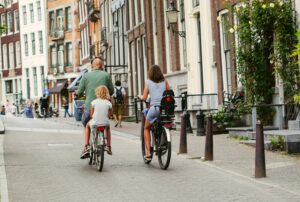 Introduction
Introduction
When was the last time you rode a bike? For myself, it had been a couple of years since I had, until recently. Every time I left for college, I would look at my bike and think, “You should bring that, you might need it,” and I always would, but I’d rarely use it. But last fall, out of nowhere, my car broke down, and suddenly I had no way to get to school. That’s when my bike became my primary form of transportation. For over a week, I took my bike to school every day, and while at first my body was tired and struggling with the added exercise, I began to enjoy my biking time, especially on the commute home when the sun was starting to set. I was sad when the weather started to get cold and I had to retire my bike for the winter, but I eagerly look forward to returning to it soon now that it’s springtime. Is your home in a bikeable city, and are you looking for a way to avoid traffic and get a little workout every day? You too could begin biking to work or school. Let’s go through a few reasons why commuting by bike is good for you and for the environment, and the ways the world is adapting to bike-lovers and this valuable transportation method.
What is a bikeable city?
A bikeable or “bike-friendly” city is not just any place where you can ride a bike to get somewhere. Instead, there are factors listed by cycling websites and researchers that help to judge and rank cities, giving them a bike-ability score that analyzes how easy it is to bike in a certain location. For example, PeopleforBikes ranks a location based on safe speeds by drivers, protected bike lanes, specific spaces for biking and walking, intersection treatments, network connections, and trusted data to ensure their scores are accurate and useful. Another important factor in a bikeable city is equity and accessibility, such as bike-sharing programs. By this ranking system, getting a score of fifty or higher is considered “a pretty darn good place to bike.” [1] In the United States, the cities that topped the list in 2023 were Minneapolis, MN; San Francisco, CA; and Seattle, WA. Internationally, the Netherlands dominates the board, with The Hague and Utrecht being the top two cities, followed by Munich, Germany. The popular biking city of Amsterdam is ranked in the top thirteen worldwide.
The benefits of living in a bikeable city
The obvious benefit to living and biking in a bikeable city is that you get a little exercise included in your day. However, this is only the tip of the iceberg in terms of the positive impacts of regular bike transportation. For you personally, biking where you need to go offers the opportunity to receive multiple health benefits, such as lowering your risk of cancer and heart disease. According to TorHoerman Law, “Just 30 minutes a day of cycling reduces a person’s chances for depression, anxiety, dementia, high blood pressure, diabetes, and cardiovascular disease by at least 40 percent.” But taking a bike doesn’t just benefit you, it benefits the environment around you, too. Traveling by bike helps to reduce carbon emissions, as fewer cars on the road mean fewer harmful gasses being released. According to the Environmental and Energy Study Institute, biking prevents upwards of 16 million tons of carbon dioxide emissions per year in the European Union. Cycling is also a more affordable way around, as there are no gas prices and no cost to park either. Not only that, but biking allows riders to avoid traffic and take in the environment around them as they get where they need to go. Biking is the cheaper, healthier, and more environmentally friendly way to commute. So why doesn’t everybody do it?
How to build more bike-friendly cities
The biggest thing that causes people to steer away from peddling to where they need to go is concerns about getting into an accident. It is an unfortunate reality that hundreds of cyclists die in traffic crashes every year in the United States. In 2024, the Centers for Disease Control reported 902 cyclist fatalities and 35,206 serious cyclist injuries. The number of accidents is often a direct result of street infrastructure that is unsafe for bikers, such as a lack of proper bike lanes, limited safety precautions for drivers, and an overall lack of cycling awareness.
To encourage more people to bike and most importantly, to decrease the risk of deaths occurring in bike accidents, proper research and action must be taken to make cities more bike-friendly worldwide. In places like the Netherlands, there are already over 22,000 miles of cycle paths, and “bicycle civil servants” take responsibility for maintaining and improving the network. Luckily, the United States has been putting in efforts to fix this problem as well. In 2020, the Congressional Bike Caucus introduced three bills, “Safe and Friendly for the Environment Streets Act (SAFE Act, H.R. 3040), Safe Routes to School Expansion Act (H.R. 5891), and the Vision Zero Act (H.R. 4819)” all to improve bike safety and decrease traffic fatalities. To prioritize bike transportation, cities also must make biking more accessible by providing things like adequate and safe places to put your bike when not using it. In addition, modifying road signs and educating people accordingly so that both cyclists and drivers can see and understand how to be safer on the road, and know how to follow the rules accordingly. If bikers don’t have a safe place to ride and the proper tools to navigate the roads, they will be more inclined to hop in their car or take the bus.
One other way that cities are encouraging residents to switch to bike transportation is by establishing e-bike rebate programs. Following the passing of the E-Bike Act by Congress, which allows a refundable tax credit for thirty percent of the cost of a qualified electric bicycle, cities throughout the United States have adopted programs to encourage e-bike purchasing. In Atlanta, for example, a $1,000,000 investment has been put in place to break down barriers to e-bike ownership, reduce transportation costs, and replace certain solo car trips. Cities such as New York and Miami also have bike-sharing options, so people can rent a bike for a certain period of time to get to where they need to go without having to own a personal bike. The more accessible and affordable biking is for people, the more likely they will try it out and the number of bikers will rise. It is critical to make cities all over more bike-friendly through proper education, action, and funding, for the good of biking communities and the world at large.
Photo by Dana Marin (Amsterdamian) for Unsplash.




